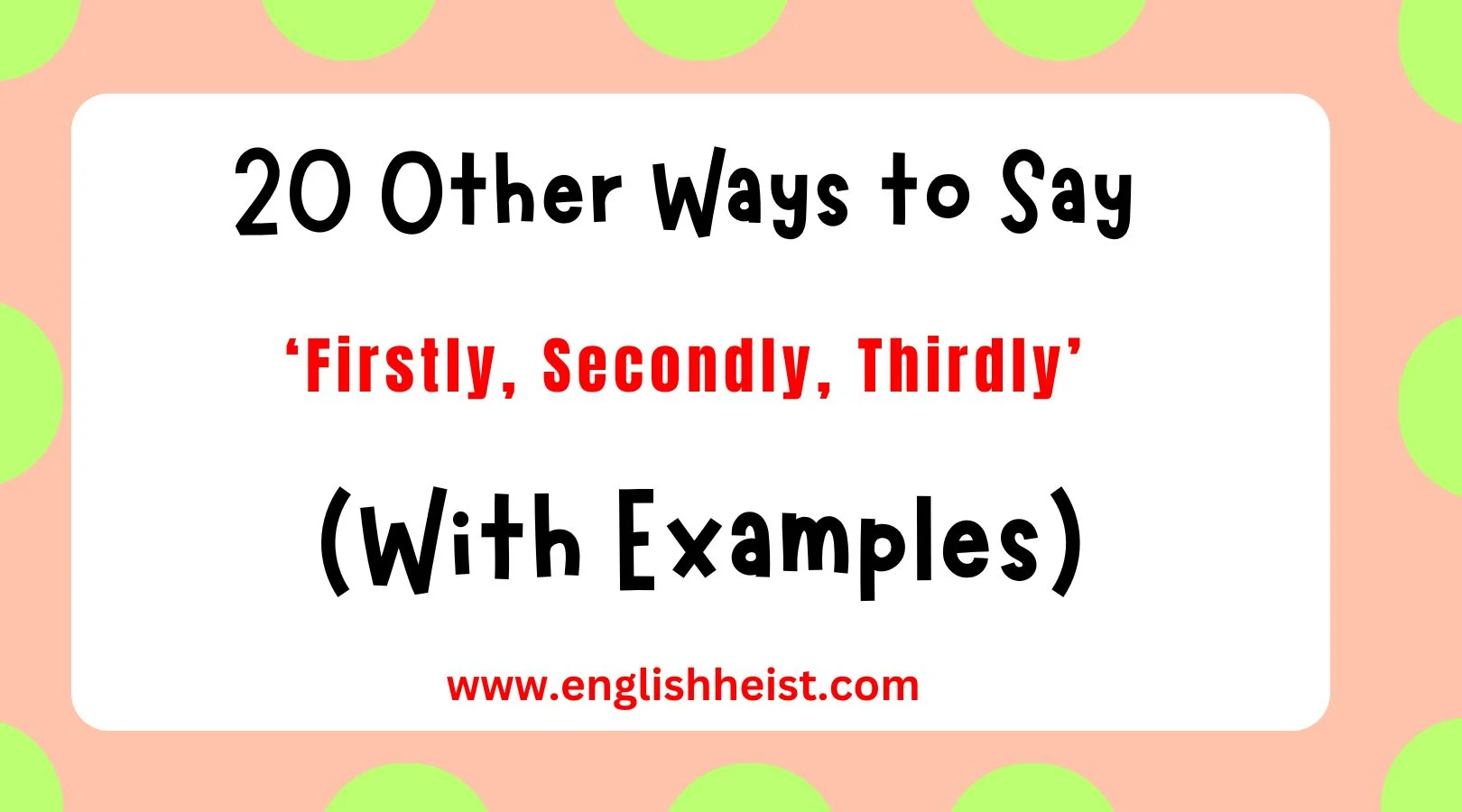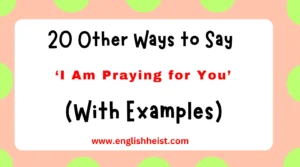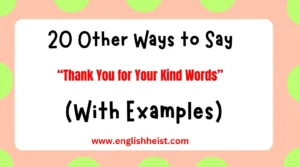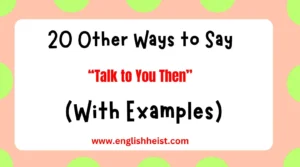Finding the right words to express ourselves can have a profound impact on how our message is received. Using phrases that feel warm and thoughtful helps make communication feel more personal and meaningful. When we speak or write, we often rely on “Firstly,” “Secondly,” and “Thirdly” to guide our thoughts.
But exploring other ways to express this structure can enhance your message. Whether you’re crafting a professional email, giving a heartfelt speech, or simply writing a blog post, these alternatives can add richness and warmth to your communication. Below are 20 alternative ways to say “Firstly, Secondly, Thirdly,” along with helpful examples and explanations.
What Does “Firstly, Secondly, Thirdly” Mean?
“Firstly, Secondly, Thirdly” are terms typically used to present ideas or points in an ordered sequence. They help guide the listener or reader through a structured argument or list, making the content easier to follow.
Is It Professional/Polite to Say “Firstly, Secondly, Thirdly”?
Yes, using “Firstly, Secondly, Thirdly” is both professional and polite. These terms are frequently used in formal writing or speeches to organize ideas clearly. However, in certain contexts, a more conversational or empathetic tone might require more varied phrasing. In these cases, the alternatives below will help.
Pros or Cons of Using “Firstly, Secondly, Thirdly”
Pros:
- Helps with structure and clarity
- Makes it easy to follow points or arguments
- Professional and polite in formal contexts
Cons:
- Can feel mechanical or repetitive if overused
- Might lack warmth or engagement in casual settings
Main Points
- “Firstly, Secondly, Thirdly” is useful for structuring ideas.
- Overuse can sound formal or repetitive.
- Alternatives can add warmth and personality.
Synonyms For ‘Firstly, Secondly, Thirdly’
- To Begin With
- First and Foremost
- Let’s Start With
- Initially
- First Off
- To Start Off
- For Starters
- First Up
- At the Outset
- From the Start
- As a First Step
- The First Point
- To Kick Things Off
- In the Beginning
- The Initial Step
- Right from the Start
- Primarily
- In the First Place
- As a Starting Point
- The Opening Idea
1. To Begin With
Scenario: Introducing the first point in a friendly and approachable way.
Examples:
- To begin with, I want to express my gratitude for all of your support.
- To begin with, we should address the most urgent issue at hand.
- To begin with, let’s talk about the new policy changes.
Best Use: Casual conversations, meetings, or emails where you want to sound warm and welcoming.
Tone: Friendly, conversational
Explanation: “To begin with” offers a gentle way to introduce your first point, setting a tone of approachability. It’s great when you want to start with a softer touch.
2. First and Foremost
Scenario: Emphasizing the importance of the first point.
Examples:
- First and foremost, I want to thank you for your commitment.
- First and foremost, our priority should be ensuring everyone feels safe.
- First and foremost, let’s take care of the essential tasks before anything else.
Best Use: Professional discussions where prioritization matters.
Tone: Emphatic, serious
Explanation: This phrase is ideal when you want to underline the significance of the first point in a more assertive yet polite way.
3. Let’s Start With
Scenario: Beginning with a relaxed, conversational approach.
Examples:
- Let’s start with the most pressing issue of today’s meeting.
- Let’s start with the introductions before we dive into the agenda.
- Let’s start with understanding everyone’s thoughts on the proposal.
Best Use: Informal meetings or casual presentations.
Tone: Friendly, collaborative
Explanation: This phrase invites the audience or reader to begin a journey with you, making it ideal for less formal settings. It fosters a sense of teamwork.
4. Initially
Scenario: Presenting your first point in a professional or academic context.
Examples:
- Initially, let’s examine the data that led to these conclusions.
- Initially, our goal is to improve communication across teams.
- Initially, we should consider the broader impact of the decision.
Best Use: Professional or academic writing where clarity is key.
Tone: Neutral, professional
Explanation: “Initially” offers a more formal way to introduce a starting point while maintaining a clear, neutral tone.
5. First Off
Scenario: Introducing the first point with a laid-back, informal tone.
Examples:
- First off, I want to say thank you for being here today.
- First off, let’s get the technical issues out of the way.
- First off, we need to clear up some misunderstandings.
Best Use: Informal emails or casual conversations.
Tone: Casual, straightforward
Explanation: “First off” is perfect for more relaxed conversations, where the goal is to come across as approachable and direct.
6. To Start Off
Scenario: Introducing a point in a light-hearted, approachable manner.
Examples:
- To start off, let’s look at the key findings of our research.
- To start off, we’ll discuss the high-level goals.
- To start off, it’s important to understand the context of the situation.
Best Use: Group discussions, presentations, or casual meetings.
Tone: Light, easy-going
Explanation: This phrase is a great way to set the tone for a collaborative discussion or meeting.
7. For Starters
Scenario: Introducing the first point in a casual or friendly way.
Examples:
- For starters, we need to make sure everyone is on the same page.
- For starters, let’s just go over the basics.
- For starters, we should explore the current trends in the industry.
Best Use: Informal conversations, discussions with friends, or lighthearted meetings.
Tone: Casual, approachable
Explanation: A friendly and easygoing way to start a conversation, “for starters” invites the listener into a relaxed discussion.
8. First Up
Scenario: Casual and quick introduction to the first point.
Examples:
- First up, let’s take a look at our key priorities.
- First up, I’ll briefly cover the schedule for the week.
- First up, we need to tackle the budget cuts.
Best Use: Casual settings, informal meetings.
Tone: Direct, energetic
Explanation: “First up” gives the conversation a quick and energetic start. It’s great when you want to get straight to the point.
9. At the Outset
Scenario: Introducing a more formal or strategic point.
Examples:
- At the outset, it’s critical to establish clear expectations.
- At the outset, we need to identify the most pressing issues.
- At the outset, let’s define the scope of this project.
Best Use: Formal presentations, reports, or professional discussions.
Tone: Formal, strategic
Explanation: This phrase works well when you want to convey a sense of planning and strategic thought right from the beginning.
10. From the Start
Scenario: A casual and direct way to begin.
Examples:
- From the start, we can already see the potential challenges ahead.
- From the start, I want to make sure we all understand the goals.
- From the start, let’s clarify what needs to be prioritized.
Best Use: Casual conversations or informal meetings.
Tone: Direct, conversational
Explanation: This expression is simple yet effective, perfect for getting straight into the main points.
11. As a First Step
Scenario: When outlining a process or a sequence of actions.
Examples:
- As a first step, we should complete the market research.
- As a first step, let’s review the initial proposal.
- As a first step, we need to gather feedback from the team.
Best Use: Step-by-step plans or instructions.
Tone: Instructional, practical
Explanation: This phrase works well when you’re outlining a clear process or next steps in a project.
12. The First Point
Scenario: Introducing the first point in an argumentative or structured manner.
Examples:
- The first point I’d like to make is about the importance of collaboration.
- The first point in our discussion is to focus on the timeline.
- The first point to consider is the long-term impact on our team.
Best Use: Debates, presentations, or formal discussions.
Tone: Structured, formal
Explanation: This phrase helps to clearly establish the first point, offering a clear and organized approach.
13. To Kick Things Off
Scenario: Starting a meeting, event, or presentation with energy.
Examples:
- To kick things off, I’d like to thank everyone for attending today.
- To kick things off, let’s go over the key objectives.
- To kick things off, we’ll begin with the most urgent concerns.
Best Use: Meetings, events, or casual group settings.
Tone: Energetic, enthusiastic
Explanation: This phrase is great for setting a lively, upbeat tone at the beginning of something.
14. In the Beginning
Scenario: Introducing the first phase of a process or event.
Examples:
- In the beginning, we need to lay the groundwork for the project.
- In the beginning, we discussed the core values of the company.
- In the beginning, our focus was on research and development.
Best Use: Describing processes or timelines.
Tone: Reflective, clear
Explanation: Ideal for narrating or explaining the start of a process or journey.
15. The Initial Step
Scenario: Breaking down a process or plan.
Examples:
- The initial step involves gathering the required resources.
- The initial step to this project is defining the scope.
- The initial step in this process is a thorough analysis.
Best Use: Process explanations or guides.
Tone: Practical, methodical
Explanation: A great way to introduce the first action in a series of steps.
16. Right from the Start
Scenario: Setting the tone for the rest of the conversation.
Examples:
- Right from the start, let’s establish the rules of engagement.
- Right from the start, we need to ensure clear communication.
- Right from the start, we can see the challenges ahead.
Best Use: Setting expectations or parameters for the conversation.
Tone: Direct, clear
Explanation: This phrase signals that you want to lay the foundation clearly from the beginning.
17. Primarily
Scenario: Focus on the primary or most important point.
Examples:
- Primarily, we need to focus on increasing efficiency.
- Primarily, we should address customer feedback.
- Primarily, let’s look at the financial aspects of this proposal.
Best Use: Focused discussions or professional settings.
Tone: Focused, professional
Explanation: This phrase emphasizes what matters most and works well when priorities are being set.
18. In the First Place
Scenario: Explaining the reason or first step in a sequence.
Examples:
- In the first place, let’s make sure the team is on board with the plan.
- In the first place, we should consider the timeline for delivery.
- In the first place, our focus must be on quality over quantity.
Best Use: Starting a sequence of actions or clarifying priorities.
Tone: Clarifying, methodical
Explanation: This is ideal for introducing foundational elements of a discussion or plan.
19. As a Starting Point
Scenario: Introducing an initial consideration or idea.
Examples:
- As a starting point, let’s discuss our current market share.
- As a starting point, let’s establish the basic requirements for the project.
- As a starting point, it’s important to get everyone’s input.
Best Use: Discussions or brainstorming sessions.
Tone: Collaborative, open
Explanation: This phrase is useful when inviting input and starting from the basics.
20. The Opening Idea
Scenario: Sharing the first idea or point in a conversation or meeting.
Examples:
- The opening idea is to restructure the team to improve communication.
- The opening idea is to reduce costs through automation.
- The opening idea focuses on increasing brand awareness.
Best Use: Starting a brainstorming session or meeting.
Tone: Open, engaging
Explanation: A great way to introduce the first idea in an open and engaging way.
Conclusion
In communication, whether formal or informal, choosing the right words can make a significant difference. By switching up your phrasing from “Firstly, Secondly, Thirdly” to any of the alternatives above, you bring warmth, clarity, and care to your message. These alternatives provide you with the tools to convey your points with the right tone and empathy, depending on the situation.
Read More:
20 Other Ways to Say “Please Keep Me Updated” (With Examples)
20 Other Ways to Say “Thank You for Your Kind Words” (With Examples)
20 Other Ways to Say ‘Talk to You Then’ (With Examples)
20 Other Ways to Say “I Hope Everything Is Going Well With You” (With Examples)
20 Other Ways to Say “Someone Who Has the Same Birthday as You” (With Examples)
20 Other Ways to Say “Emotional Intelligence” (With Examples)

Mia Rose is your go-to platform for mastering the English language. Through clear, concise lessons and expert advice, Mia makes learning grammar, vocabulary, and writing skills easy and enjoyable. Whether you’re a beginner or looking to refine your skills, English Heist helps you communicate confidently and effectively.













